0. Investment Overview (Executive Summary)
0.1 TL;DR
The Pendle project is well-structured, with transparent data and a reasonable token distribution. The team's background and technical capabilities are excellent, with core members being stable over the long term and capable of independently advancing complex systems. In terms of token structure, although the tokens for the team and foundation have all been unlocked, the overall selling pace is rational and restrained, demonstrating a good long-term perspective. Pendle excels in "trustworthiness" and "medium to long-term delivery capability," making it a typical "hardcore" DeFi project.
From a product and technical perspective, Pendle's core mechanism (PT + YT split) creates a new on-chain interest rate logic, and the AMM design shows a high understanding of financial engineering, successfully commercializing yield rights trading. Additionally, it introduces innovations such as points and airdrop rights, combining profitability with game theory. Pendle far exceeds similar projects in "product engineering capability" and "mechanism design ability," making it a protocol with a deep moat.
From the product roadmap perspective, Pendle's development path is clear and robust, completing the transition from LRT-driven to yield-stablecoin-dominated market from 2023 to 2024, and clearly proposing expansion into funding rates and non-EVM ecosystems in 2025, continuously extending its lifecycle. From this aspect, Pendle demonstrates strong strategic execution and clear direction, being one of the few DeFi projects capable of "independently seeking a second growth curve."
From the economic model perspective, Pendle adopts a veToken structure to achieve a closed-loop token value: locking tokens for governance, obtaining profit sharing, and enhancing LP returns. Revenue mainly comes from YT yield fees and PT transaction fees, with no official cut, all returned to the community. However, the valuation under transaction fees is somewhat overestimated, reflecting the market's high expectations for its future.
From the market potential perspective, the on-chain interest rate market where Pendle operates is far from fully developed, with potential markets including: stablecoin interest rate spreads, LRT, RWA, and funding rates, potentially reaching hundreds of billions of dollars. Currently, Pendle has dominated the Ethereum ecosystem and is expanding to Solana, TON, Hyperliquid, etc. As a protocol-level platform at the critical point of the on-chain interest rate market explosion, Pendle has extremely high long-term growth potential, but its development still heavily relies on the continuous expansion of the overall scale of interest rate products.
0.2 Narrative and Investment
The interest rate market infrastructure built by Pendle is highly forward-looking, establishing a standard layer for on-chain fixed income and yield rights trading, successfully accommodating multiple market themes such as LRT, stablecoins, and airdrop points. Its business direction and trends are highly aligned, with a sound governance mechanism and a clear closed-loop revenue structure. From this part, Pendle has clear narrative anchors and valuation expectations, exhibiting typical characteristics of a "strong narrative + resilient fundamentals" project, suitable for medium to long-term allocation.
● Short-term: As the stablecoin sector welcomes a "second spring," the PayFi and airdrop narratives continue to ferment, Pendle is expected to gain market gaming space; however, it should be noted that current on-chain data shows a downward trend, which may exert some pressure on short-term token prices.
● Mid-term: With the launch of Boros, the funding rate market will be integrated, activating a new customer base and ushering in a new narrative phase.
● Long-term: Pendle is expected to become the "structural core facility" of the on-chain interest rate market, playing a role similar to that of interest rate swap platforms in TradFi, with a vast market space and potential for continuous expansion and growth.
For long-term investors:
Although Pendle may have some short-term premium at this stage, from a long-term perspective, its brand recognition, diversity of user structure, risk resistance, and potential growth space in market share all have significant advantages. The project's medium to long-term growth potential is clear, making it suitable for gradually building positions through dollar-cost averaging, and it is recommended to start positioning immediately.
For short to mid-term participants:
Due to market volatility in the short term, and with swap fees currently experiencing a slow weekly decline, we recommend closely monitoring:
Whether the stablecoin market will welcome a second wave of momentum: Recently, several stablecoin projects have received financing support, which is expected to reactivate the sector in the short term. As one of the main accommodating platforms, Pendle may benefit from this influx of funds and users.
Whether new user groups emerge: From the early LRT to the current stablecoin users, Pendle's core appeal lies in its ability to trade interest rate-related assets. If it can cover new scenarios or add new ecosystem user groups, such as PayFi, it will become a key node for driving mid-term growth.
1. Basic Overview
1.1 Project Introduction
Pendle Finance is a decentralized interest rate trading protocol built on the Ethereum ecosystem, with the vision of becoming the infrastructure for the on-chain interest rate market. Pendle has created an on-chain native yield rights market, opening a new track for "fixed income" and "yield derivatives" in DeFi, and is hailed as the "Uniswap of the interest rate market in DeFi."
1.2 Basic Information
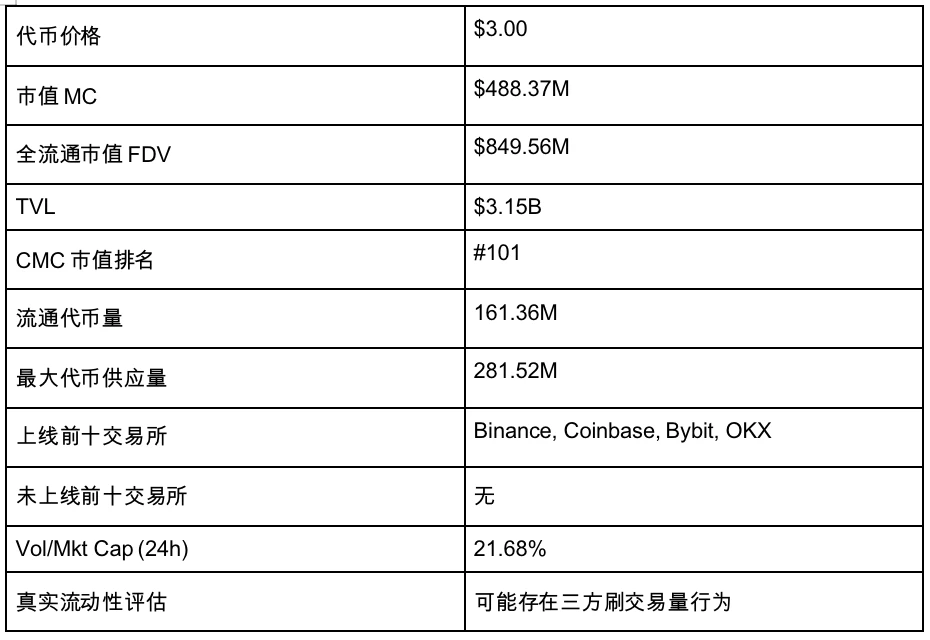
1.3 Team and Background Check
Pendle was established in 2021, with team members based in Singapore and Vietnam. Currently, there are about 30 people registered on LinkedIn, with an average tenure of around 2.1 years, and the management team is relatively stable.
TN Lee (X: @tn_pendle): Co-Founder, previously a founding team member and business leader at Kyber Network, later joined mining company RockMiner, which operates about 5 mining farms. In 2019, he founded Dana Labs, mainly focusing on FPGA customized semiconductors.
Vu Nguyen (X: @gabavineb): Co-Founder, previously served as CTO at Digix DAO, specializing in the tokenization of physical assets in RWA projects, later co-founded Pendle with TN Lee.
Long Vuong Hoang (X: @unclegrandpa925): Engineering Director, holds a Bachelor's degree in Computer Science from the National University of Singapore, joined as a teaching assistant in January 2020, became a software engineering intern at Jump Trading in May 2021, and joined Pendle as a smart contract engineer in January 2021, later promoted to Engineering Director in December 2022.
Ken Chia (X: @imkenchia): Institutional Relations Director, holds a Bachelor's degree from Monash University, previously an investment banking intern at CIMB, Malaysia's second-largest bank, and later an asset planning specialist in private banking at JPMorgan. He entered Web3 in 2018, serving as COO at an exchange, and joined Pendle in April 2023 as the institutional director, responsible for the institutional market—proprietary trading firms, cryptocurrency funds, DAO/protocol treasuries, and family offices.
Daniel Anthony Wong: Growth Director, holds a Bachelor's degree in Electronics and Electrical Engineering from Nanyang Technological University, and has been with Pendle for about four years since graduation.
1.4 Funding / Financing Situation
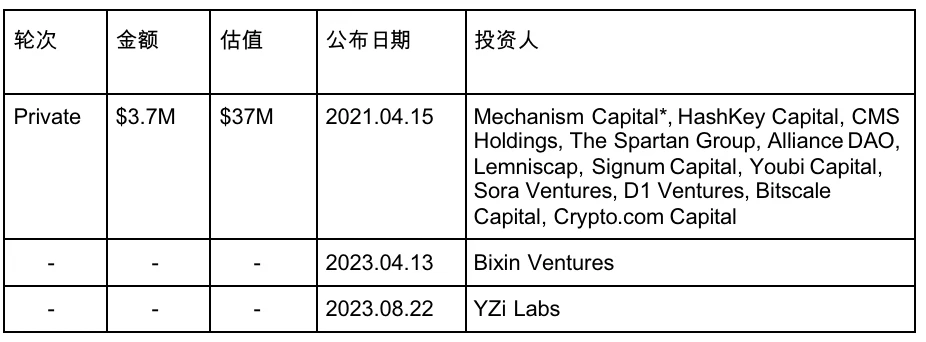
2. Products and Technology
2.1 Background
The DeFi world lacks a native interest rate market, and traditional interest rate tools cannot be replicated on-chain. Pendle opens a path for on-chain fixed income through its yield rights separation mechanism. Pendle's core vision is to transform all yield-bearing assets into tradable yield products, achieving fixed income, interest rate speculation, and the commercialization of yield financial products.
2.2 Core Product Introduction
Pendle positions itself as an interest rate swap market. It is a decentralized yield trading protocol built on Ethereum, allowing users to split, price, trade, and combine future yield cash flows.
Its core function is to decompose yield-bearing assets (such as interest-bearing stablecoins, staked tokens, etc.) into two tradable components: Principal Token (PT) and Yield Token (YT), thus forming an "interest rate swap market."
This mechanism provides unprecedented flexibility for DeFi, enabling users to manage interest rate risk, lock in fixed income, or speculate on future yield trends, just like in traditional financial markets.
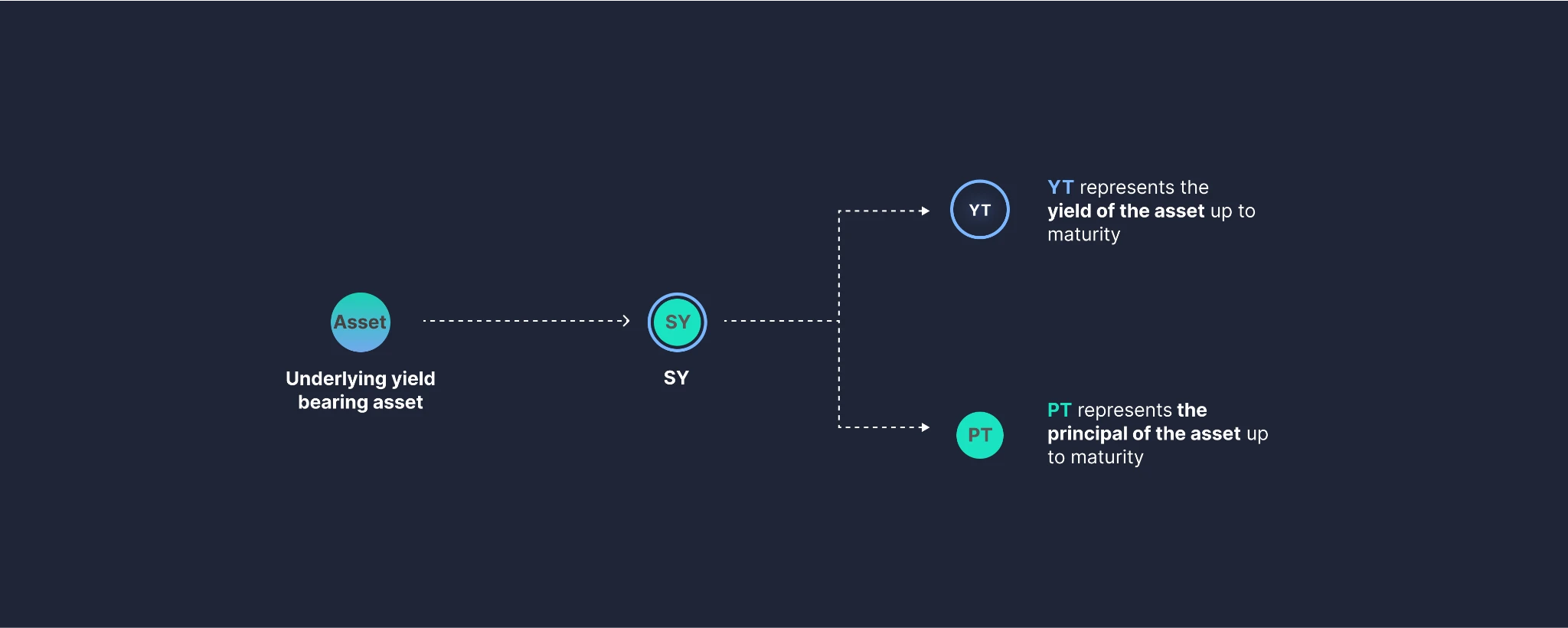
Pendle mechanism, source: Pendle
Pendle supports various yield-bearing assets through a standardized yield asset interface (Standardized Yield, SY). Once entering Pendle, these assets are decomposed into:
● PT (Principal Token): Represents only the principal rights, redeemable 1:1 at maturity;
● YT (Yield Token): Represents future yield rights, with the price depending on future interest rate expectations.
Additionally, Pendle has built an automated market-making system that provides liquidity and combinability for the PT and YT markets, introducing a pool structure with low trading slippage and strong mining incentives to attract long-term capital and DeFi professional users.
For example: sUSDe pool maturing on 2025-05-29
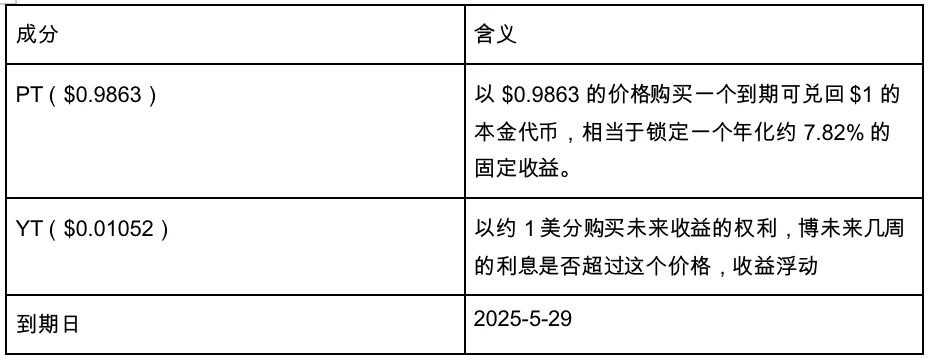
● Buy PT or sell YT to lock in future yields. If you hold sUSDe wrapped by Pendle (i.e., converted from USDe), you can split sUSDe into YT and PT through AMM. You can choose to sell YT (which represents the future 7.82% yield) to lock in your 7.82% yield in advance; alternatively, you can directly buy PT at a discount in the market, redeemable 1:1 at maturity, which is also a way to lock in a 7.82% yield.
● Buy YT to bet on future yield increases. If you believe that future on-chain market conditions or other factors will lead to an increase in the yield of USDe, you can buy YT currently priced under low interest rates, speculating that future YT yields will exceed the yield at the time of purchase.
The trading of PT / YT mainly relies on Pendle Finance's automated market maker (AMM), which is a core component of the protocol and a primary source of profit, specifically designed for trading Principal Tokens (PT) and Yield Tokens (YT). Unlike traditional constant product formulas (such as Uniswap's AMM), Pendle's AMM considers the impact of time on asset value, dynamically adjusting its curve over time to reflect the accumulation of yields and changes in the price range of PT.
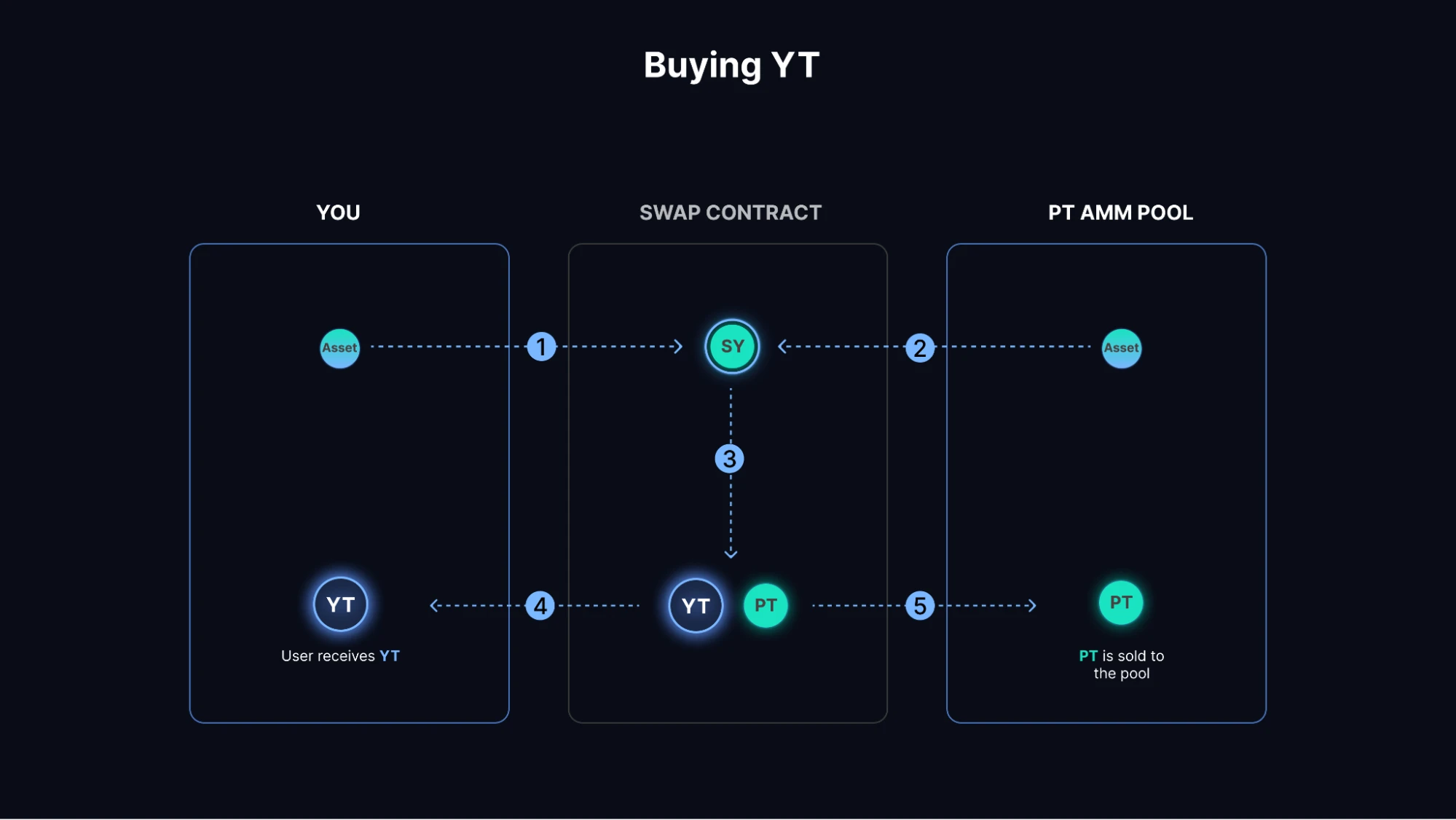
Its core components are: the virtual AMM for PT and SY. This design allows users to directly use SY to purchase PT, thereby locking in future yields, and also enables the buying and selling of YT (Yield Tokens) through a "Flash Swap" mechanism.
The specific trading process is as follows (the user holds USDC but wants to buy YT of USDe):
After the Swap contract receives USDC, it will use USDC to purchase the corresponding SY asset in the virtual AMM pool, which is sUSDe here. Subsequently, sUSDe will be split into YT and PT assets by the Mint contract, with the YT asset sent to the user's address, while the PT asset is sold in the AMM Pool. In this way, the user obtains the limited yield rights of the Ethena USDe asset as well as point rights (Ethena Points).
PT (Principal Token) + YT (Yield Token) = Current value of SY
This is the core algorithm of the AMM mechanism, meaning that there is a direct correlation between the prices of PT and YT. If the market sells off PT, YT often rises to offset the price drop caused by the PT sell-off, ultimately achieving an asset value equal to SY. Therefore, even if there are only PT and SY in the pool, the price of YT can be derived without constructing two AMM pools.

PT YT and SY correlation
On the other hand, taking sUSDC as an example, assuming a maturity date of 90 days, as the maturity date approaches, the yield will gradually approach 0, and thus the price of YT will also gradually approach zero, while PT will gradually approach 1. We can understand YT as the capital yield rights over a certain period.
Pendle derivative gameplay: combining the current point mechanism of the airdrop market. For example, projects like Ethena, EigenLayer, Renzo, KelpDAO, etc., will issue points to users holding tokens (such as sUSDe, ezETH, rsETH) or staking, which represent future token airdrop shares. You can "sell" future point yield rights or "lend out assets to earn point yields, with others paying interest." The logic of this gameplay is the same as YT (capital yield rights), except that the underlying asset is "points" rather than "interest."
3. Project Development History
3.1 Past

3.2 Present
3.2.1 Ecosystem Development
Last year, its ecosystem was mainly focused on LRT. With the end of the EigenLayer airdrop, the LRT track began to decline, and Pendle's TVL, token price, and ecosystem activity also saw significant declines. After aligning with the growth trend of stablecoins, it has welcomed growth again, with the following being its main stablecoin ecosystem partnership projects:
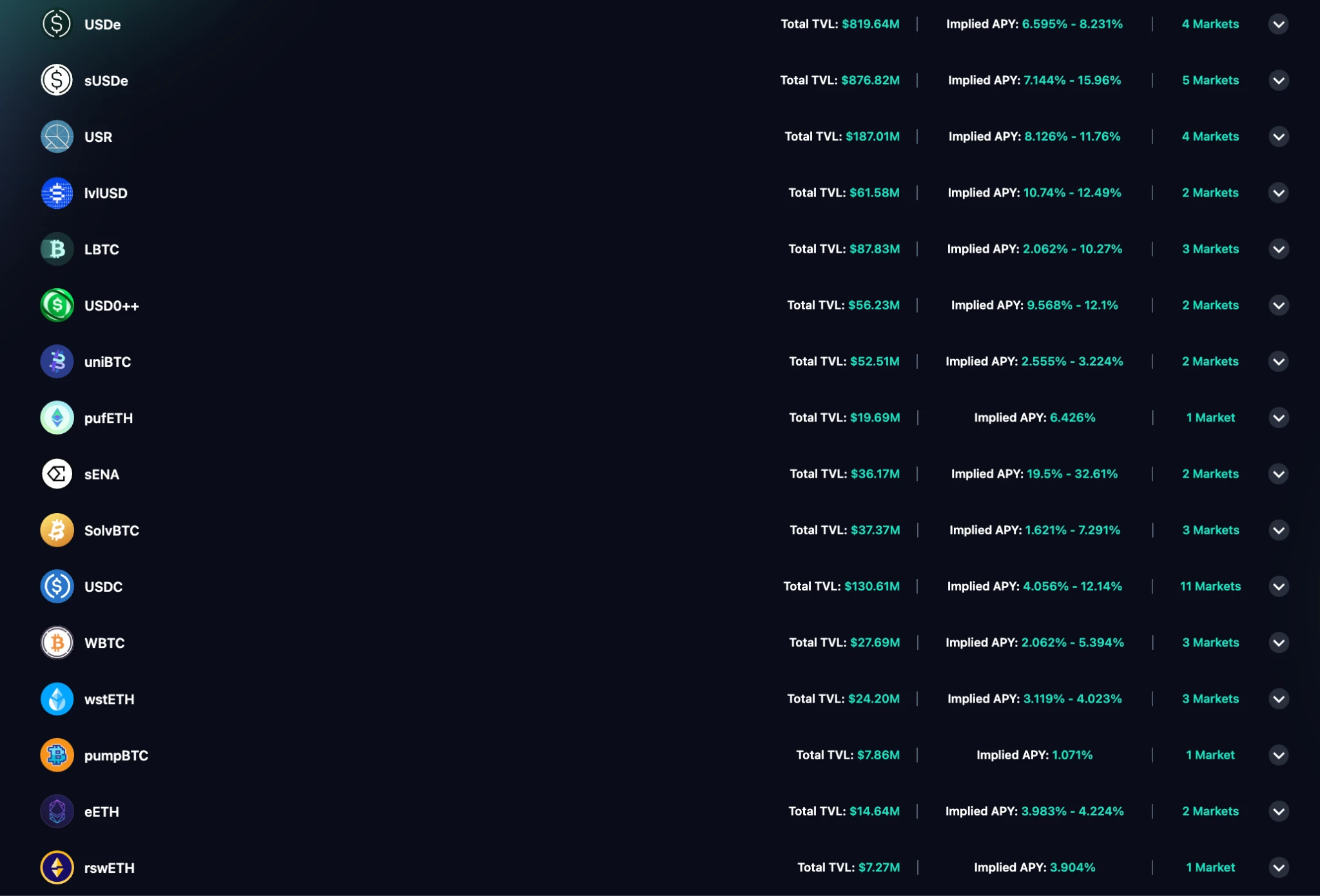
The landscape of ecosystem, source: Pendle

Active Users, source: Tokenterminal
In the past month, Pendle's monthly active users have been around 16K, showing a downward trend in active users.
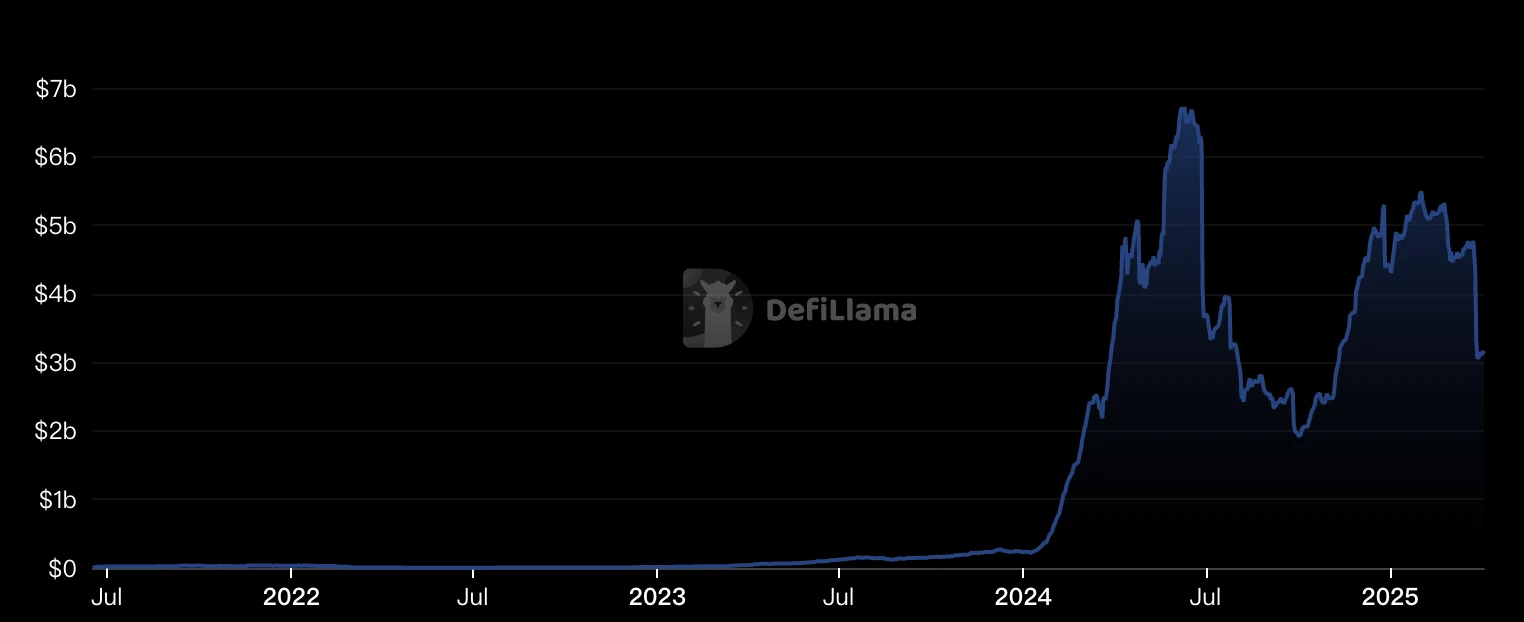
TVL, source: Defillama
DeFi products have recently been significantly affected by market fluctuations, leading to a severe decline in TVL calculated in USD terms. It has dropped from $4.8 billion at the beginning of the year to $3.1 billion now, a decrease of 35%.
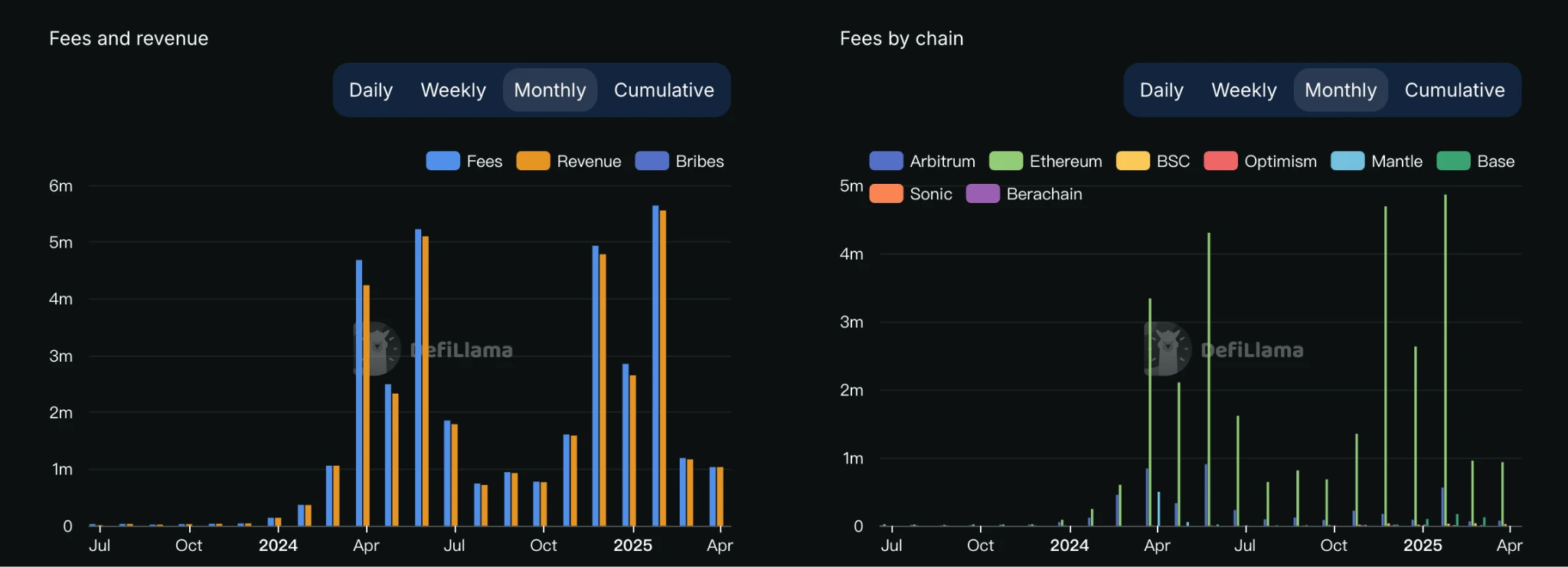
Fees and Revenue, source: Defillama
Pendle's fee income has been around one million dollars in the past two months.

DEX Trading Volume, source: Defillama
Although DEX trading volume saw a rebound in mid-March, it has generally maintained a downward trend, reflecting the continued sluggishness of the overall Ethereum chain market. In March, Pendle DEX's trading volume was $2.75 billion, averaging $100 million per day, a level comparable to Hyperliquid's daily spot trading volume, while Uniswap's daily trading volume during the same period was $1.7 billion.
3.2.2 Social Media

Overall, Pendle has a stable community foundation and good market attention.
3.3 Future
According to an article released by the Pendle team on February 4, 2025, titled "Pendle 2025: Zenith," Pendle's main plans for 2025 include the following three aspects:
Pendle V2 Improvements: Plans to enhance protocol performance and user experience through the following means:
● Enhanced openness: Providing features in the user interface that allow users to create yield markets themselves, thus achieving community-driven growth.
● Dynamic fee adjustments: Implementing a dynamic fee rebalancing mechanism to ensure a balance of interests among liquidity providers, users, and the protocol.
vePENDLE Improvements: Expanding the functionality of vePENDLE to allow all users to participate in voting and optimizing protocol revenue for vePENDLE holders.
Establishing Citadels: Aimed at expanding Pendle's influence, specific measures include:
● Supporting PT for non-EVM ecosystems: Expanding fixed income products to non-EVM chains like Solana and TON to attract new user groups.
● PT for traditional finance: Developing compliant products to provide institutional investors access to crypto fixed income products.
● PT for Islamic funds: Creating Sharia-compliant financial products to enter the Islamic finance market.
Launching Boros: A new platform aimed at supporting any type of yield trading, initially focusing on funding rates in the crypto market.
4. Economic Model
4.1 Initial Token Distribution
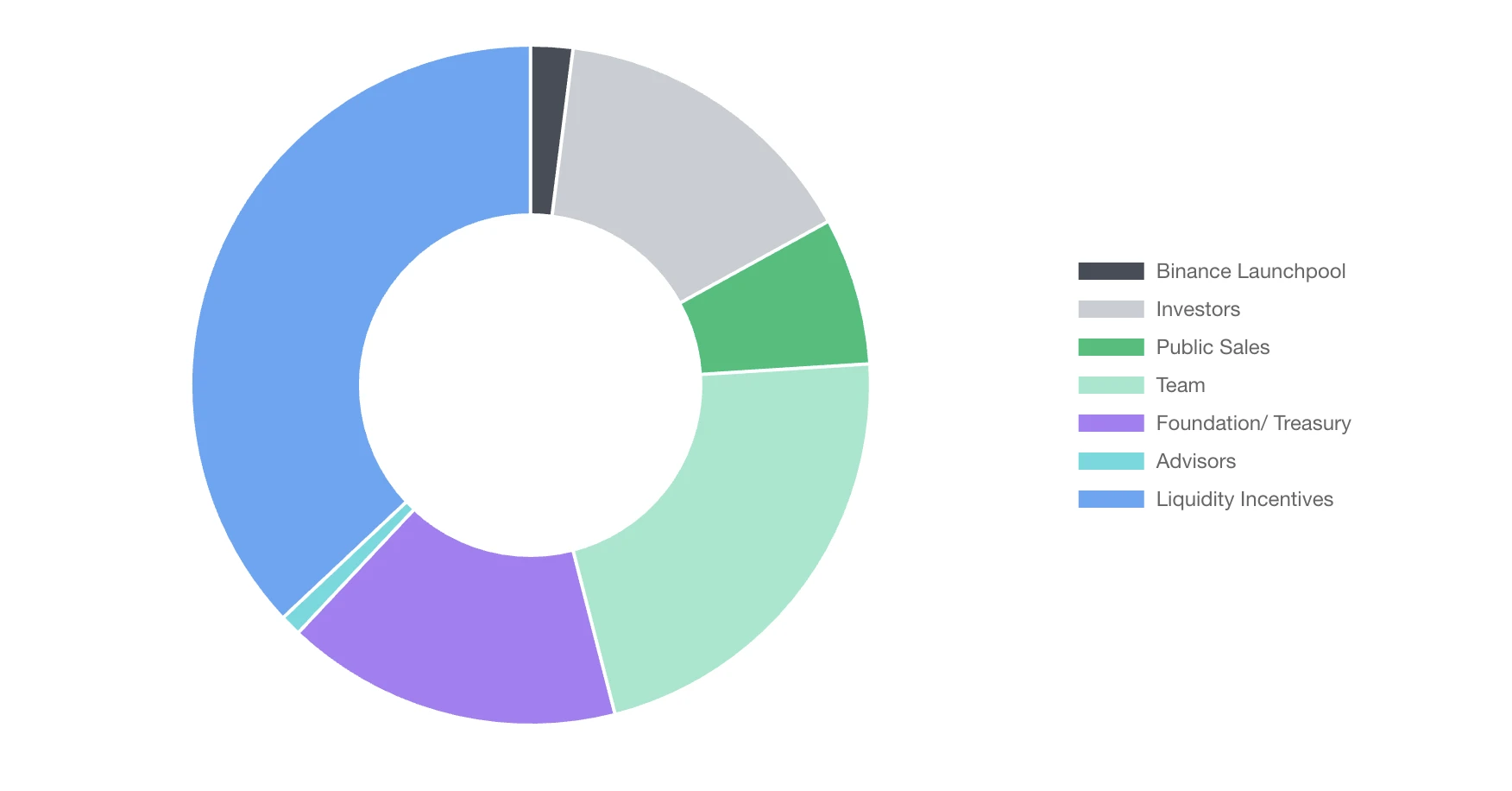
Token Distribution, source: Binance
This chart is from the token distribution on Binance Launchpad in July 2023, with liquidity incentives accounting for 37%, distributed by the team; the foundation and treasury account for 16%, the team for 22%, investors for 15%, public offerings for 7%, and Binance Launchpad for 2%. By September 2024, all tokens for investors and the team will be fully vested.
4.3 Token Use Cases
Pendle tokens can be converted to vPendle, enjoying:
Voting to decide which liquidity pools to introduce $PENDLE incentives, with voting rights related to the amount and duration of Pendle staked.
If you participate in voting for that pool, you receive 80% of the swap fee income from that pool.
A 3% fee from the revenue generated from YT is distributed to all vPendle holders.
The 3% interest collected from YT and the maturing PT rewards constitute the basic APY of vePENDLE, combined with active voting to build total rewards.
Overall, in terms of token empowerment, all functions of the Pendle protocol are essentially related to vPendle.
4.2 Token Holder Address Analysis
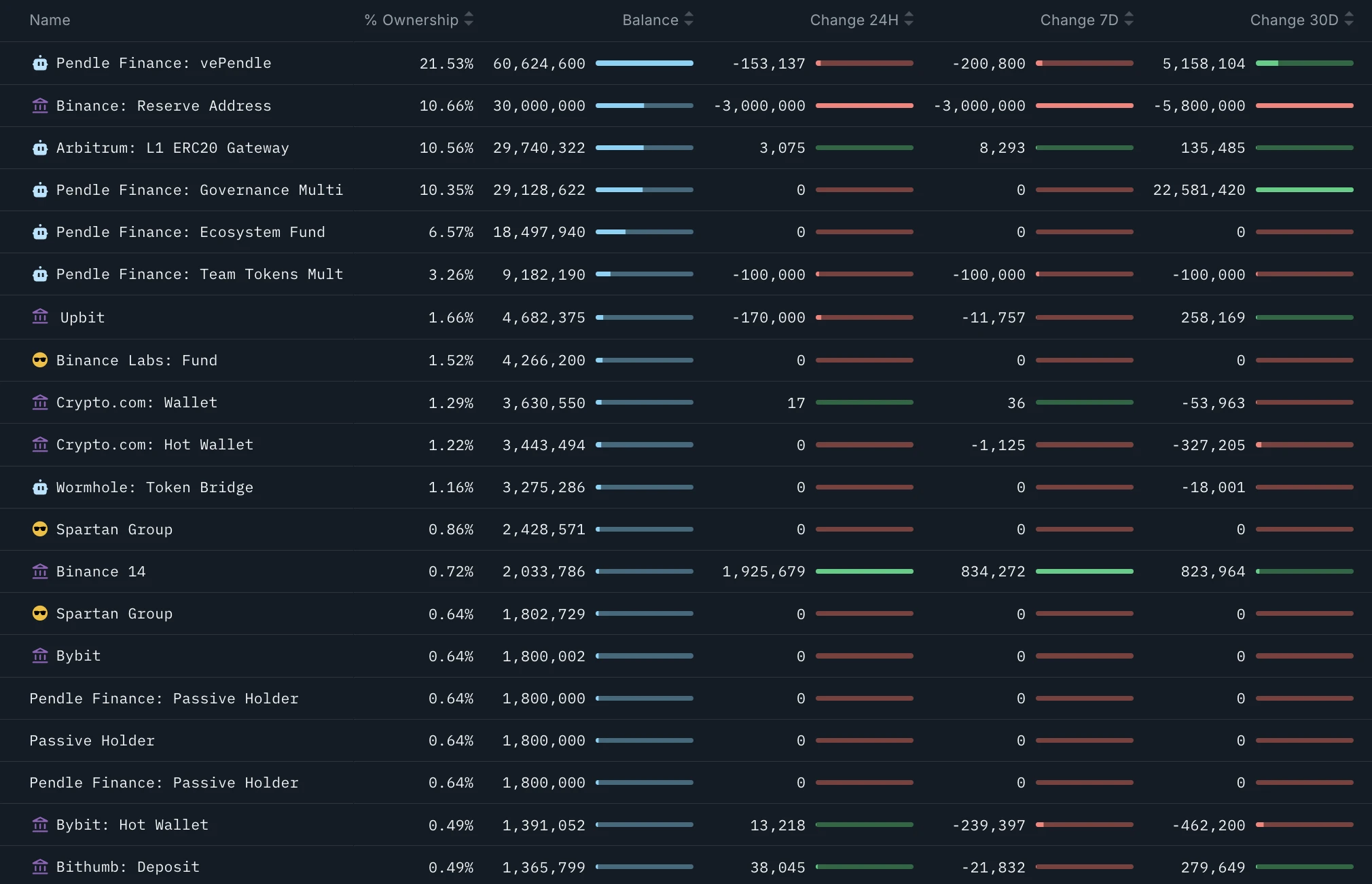
On-chain Pendle holdings, source: Nansen
According to on-chain data, the main VC holdings of Pendle are as follows:
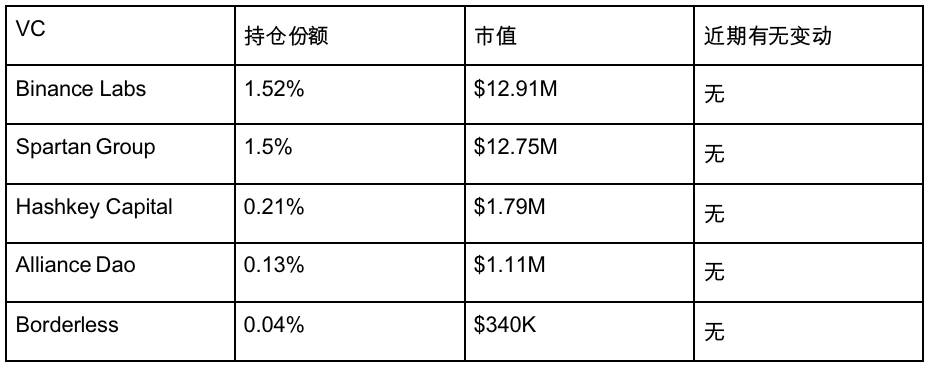
Holdings from major exchanges are as follows:
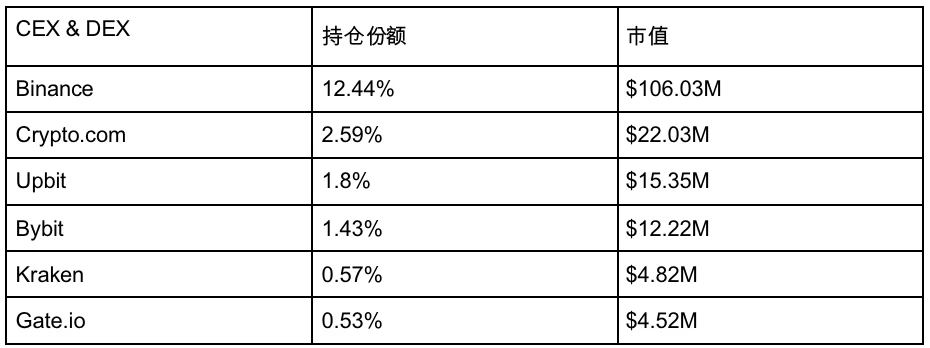
Binance has accumulated a large amount of Pendle tokens, including Binance Labs, accounting for a total of 14% of the total supply. However, since only 50% of the total supply is currently in circulation, this portion actually accounts for 24% of the market's circulating supply, giving it significant influence over market prices.
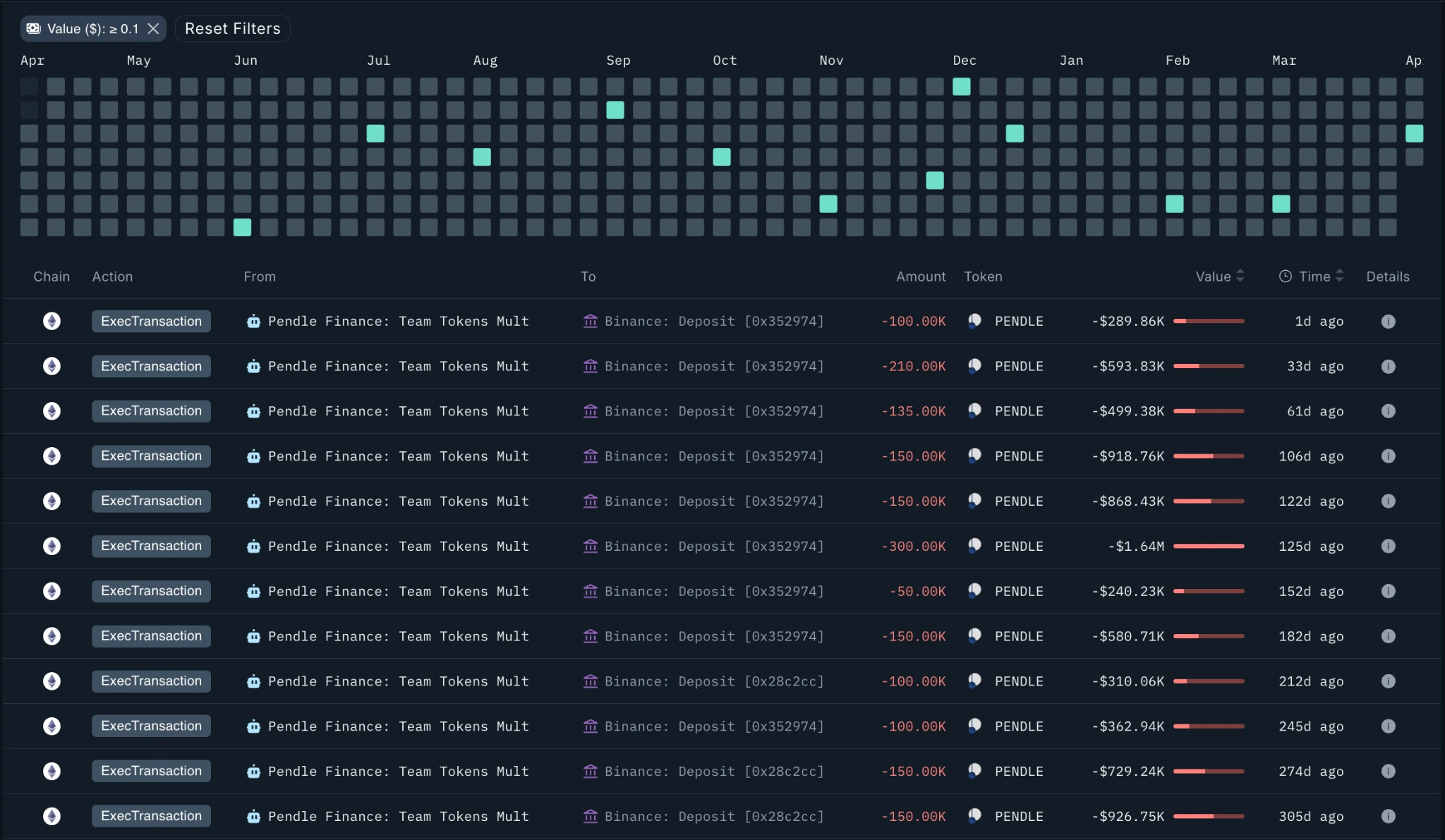
Currently, the team (excluding Foundation & Treasury) still holds 9.2 million tokens, valued at approximately $27.6 million. This portion is classified by the team as non-circulating tokens, but it has actually been fully unlocked. The team does not sell tokens frequently, averaging 1-2 sales per month, with each sale ranging from 100,000 to 300,000 tokens, amounting to approximately $300,000 to $900,000 at current prices.
The ecosystem incentive fund has sold a total of 3.36 million tokens over the past year, with 1.6 million tokens received.
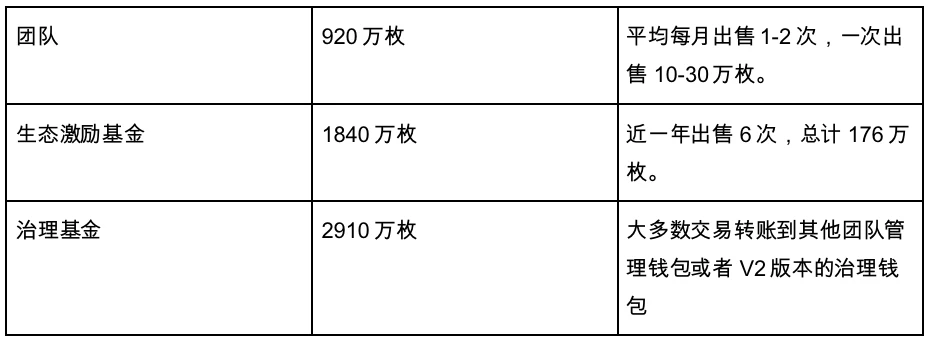
Overall, both the team's and the ecosystem incentive fund's token allocations remain at a high level, with token sales being relatively restrained, indicating strong sustainability.
4.4 Token Market Value & Circulation
Here is our recalculated token distribution:
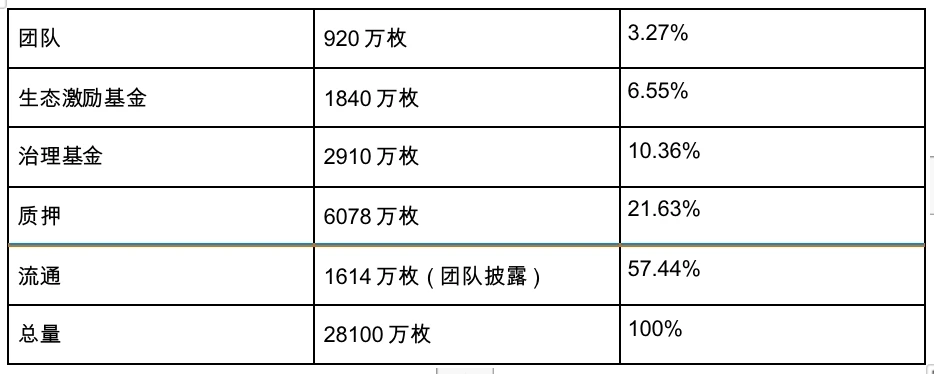
The basic data aligns correctly. It is worth noting that the Pendle team has explicitly stated in official documents that while the team reserves, ecosystem incentives, and governance fund portions have all been unlocked, they are not included in the circulating supply.
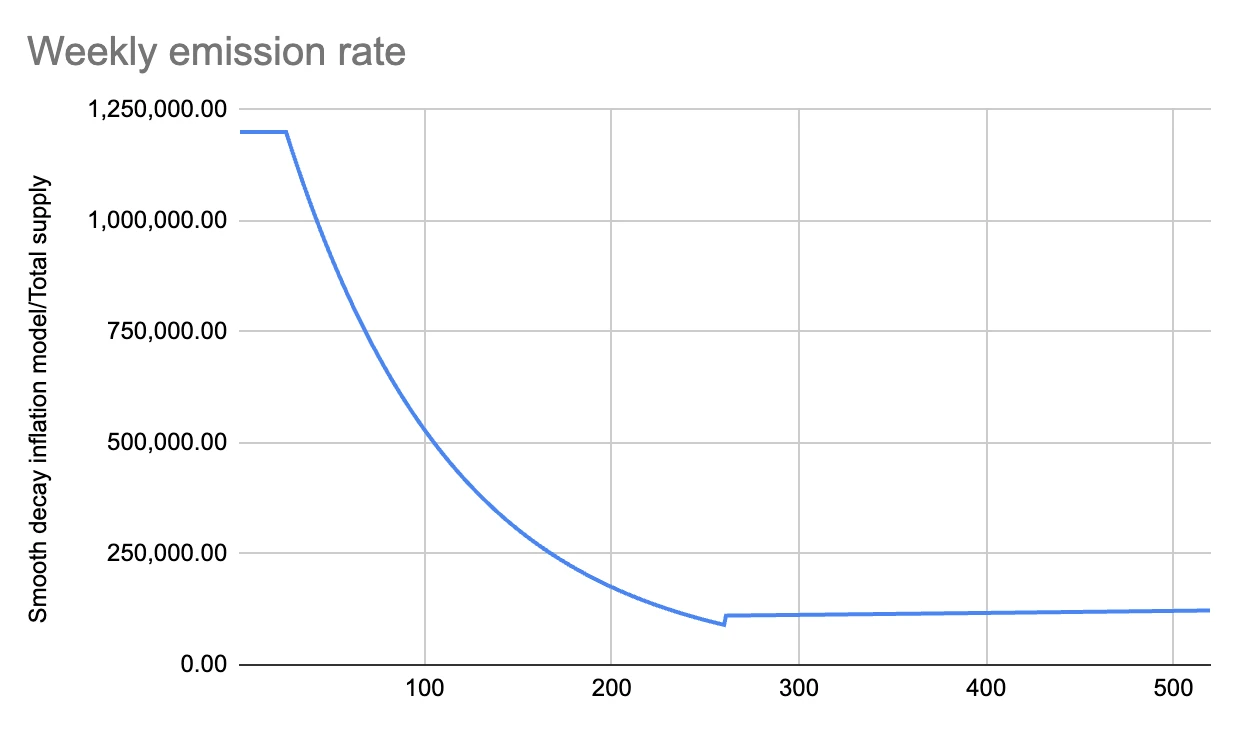
Token Inflation, source: Pendle
As of September 2024, the weekly emission is 216,076, decreasing by 1.1% each week until April 2026. At that point, Pendle's inflation model will shift to a final inflation rate of 2% per year to provide ecosystem incentives. By calculation, a total of 7,119,017 PENDLE will be emitted in 2025, with an average annual inflation rate of approximately 2.2%. In 2026, it will approach 2%. The inflation rate is relatively healthy.
5. Market Potential
5.1 Accessible Market
Pendle has impressive data at first glance, but after in-depth research, we found that, similar to other dividend-type products, Pendle's dividend capacity is insufficient to support its high FDV (Fully Diluted Valuation) of $900 million. We believe that the current valuation premium of Pendle mainly stems from its enormous market potential and its unique position as a pioneer in the on-chain interest rate market.
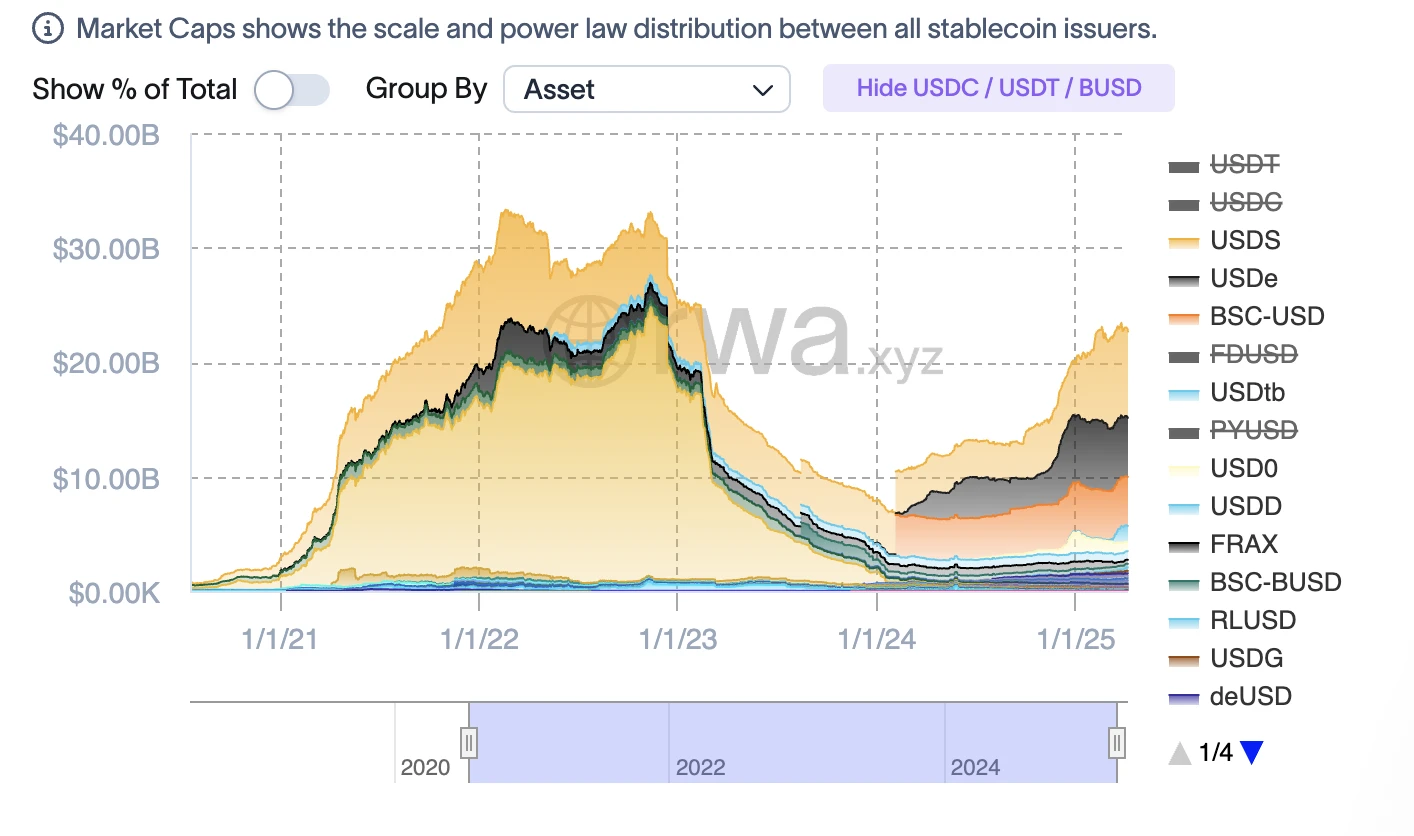
The market cap of Stablecoins, source: RWA.xyz
The arrival of the stablecoin market is closely related to the price performance of the cryptocurrency market itself. During the last bear market phase for BTC, approximately from January 2022 to January 2023, this period was also when the stablecoin sector was active, with retail investors more inclined to pursue stablecoin yield returns. From experience, stablecoin markets typically last for about a year. Coupled with the financing situation in the primary market, projects on MegaEth's CAP and the M^0 project on the Ethereum mainnet have just completed financing, and these projects will mostly prioritize collaboration with Pendle.
Currently, about 80% of Pendle's business is still concentrated on the Ethereum mainnet. According to its 2025 roadmap, the team has clearly planned to expand to multiple chains, including Solana, Hyperliquid, and Ton. We believe that, given Pendle's unique brand influence in the on-chain interest rate market, it is highly likely to dominate the market share of these three chains in the interest rate sector.
At the same time, all future dividend-type gameplay/track will generate demand for Pendle-type products. For example, the swap fee income previously dominated by LRT is now driven by high-yield stablecoins. This indicates that its business model does not rely on a single customer group but possesses high elasticity and long-term operational potential.
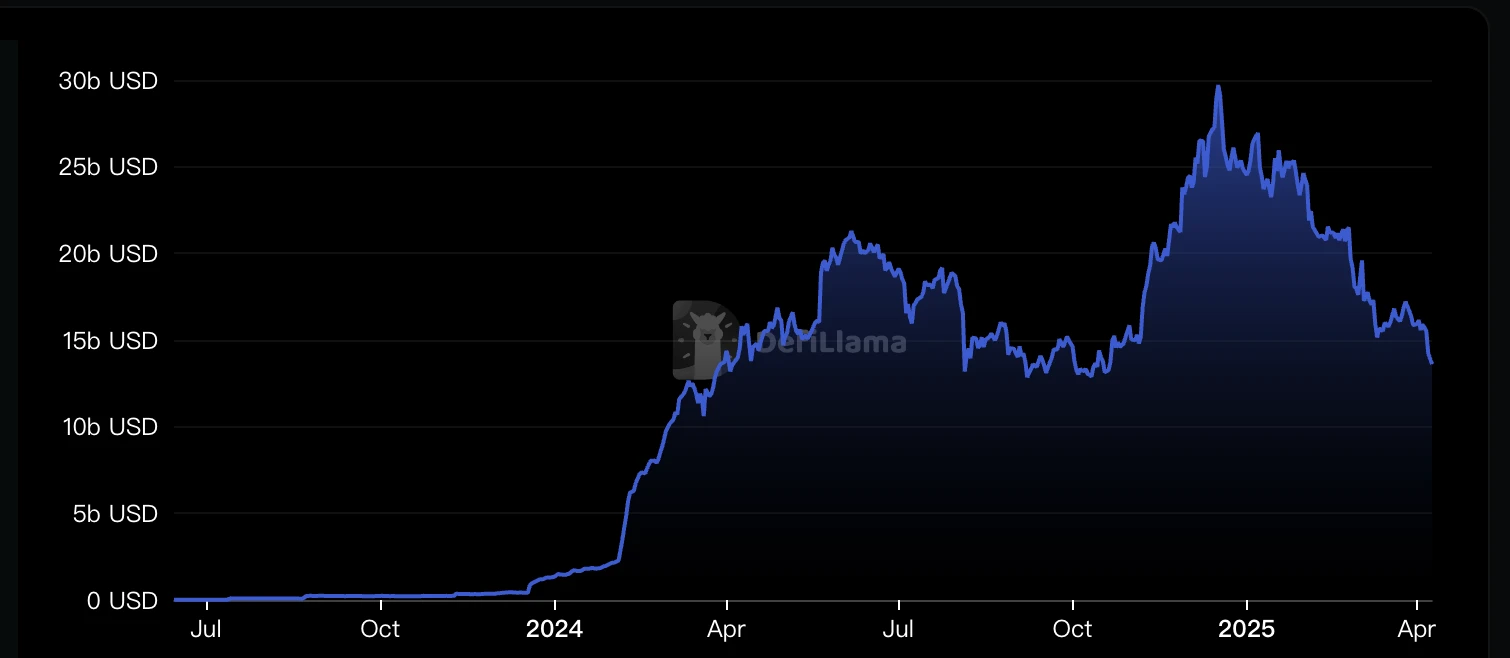
Liquid Staking Market, source: Defillama
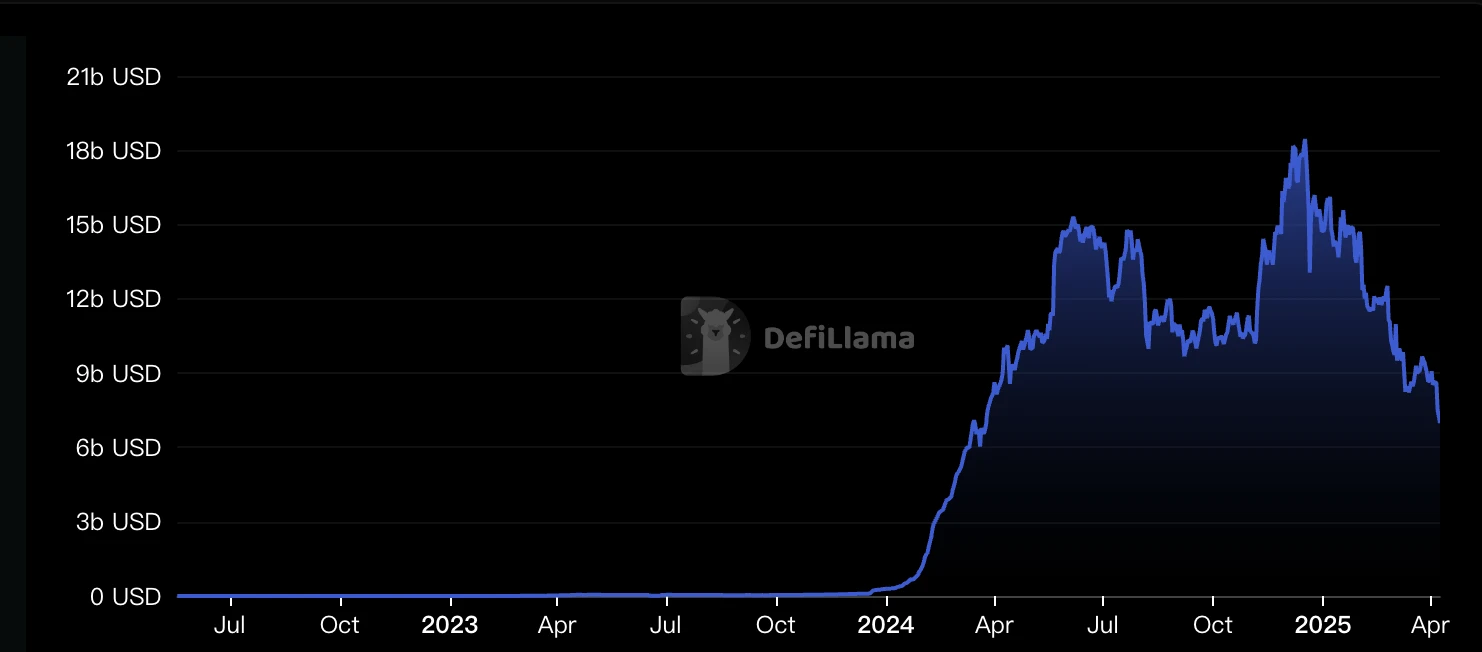
Liquid Restaking Market, source: Defillama
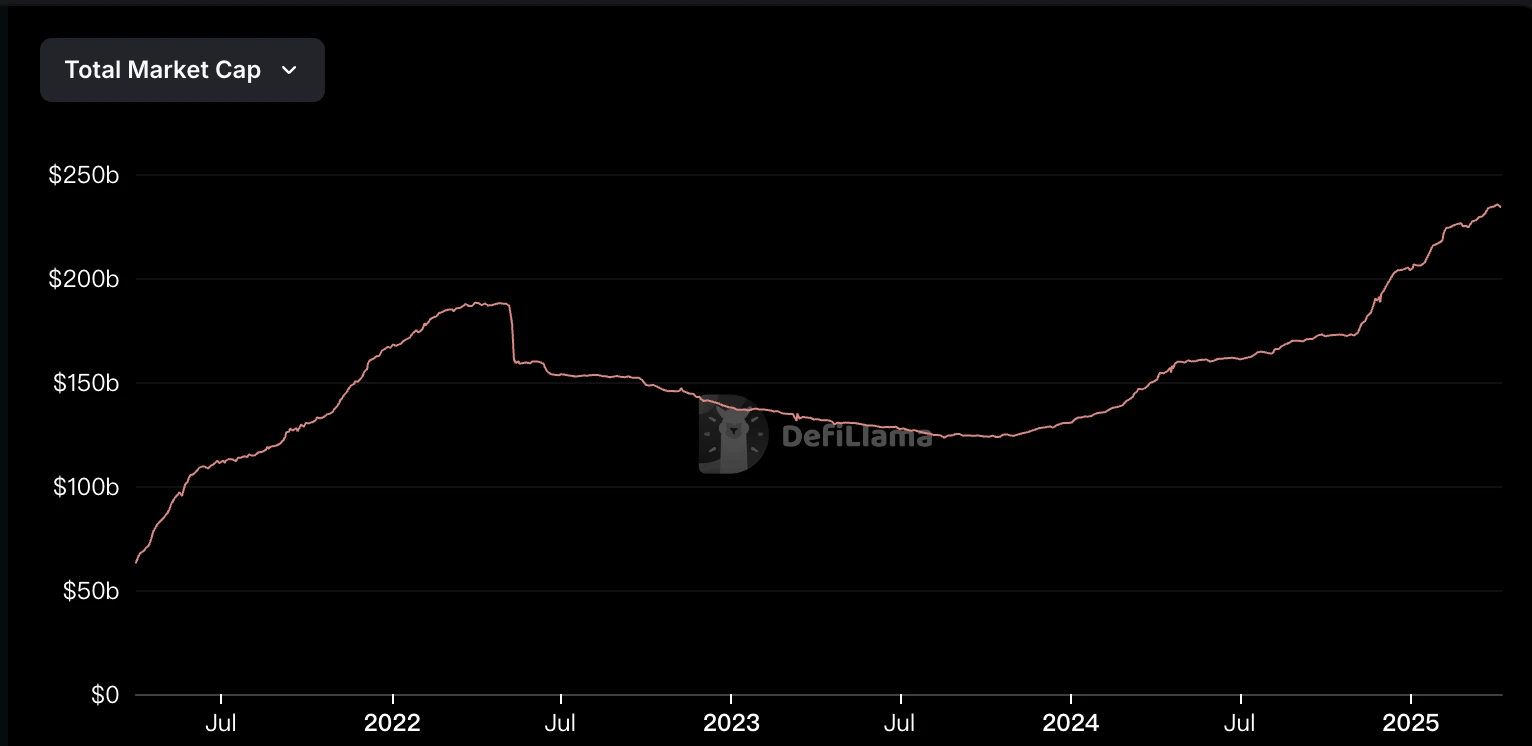
Stablecoins Market, source: Defillama
The Liquid Staking ($15 billion) + Liquid Restaking ($7 billion) + Stablecoins ($233.5 billion) market currently totals approximately $255 billion in accessible market share. Meanwhile, Solana, Hyperliquid, and Ton chains are still in development, and the demand for interest rate swaps for stablecoins has just begun.
At the same time, Pendle plans to develop interest rate products compatible with traditional finance and will launch interest rate swap tools for perpetual contract funding rates in 2025. It is worth noting that the trading volume in the contract market is usually several times that of the spot market, which will further expand its potential market.
In summary, the interest rate swap sector that Pendle is entering not only has enormous application prospects and real market demand but, with the increasing integration of traditional finance and DeFi, Pendle is expected to maintain a dominant position in this sector due to its first-mover advantage.
5.2 Business Model and Revenue
The growth of fees is divided into swap fees and YT, with the vast majority coming from swap fees. It is noteworthy that, unlike the fixed percentage fee model (e.g., 0.3%) based on trading volume that we are familiar with, Pendle does not charge fees based on trading volume but rather based on the future yield represented by PT. This means that even if a transaction has a high trading volume, if the PT being traded is nearing maturity and the corresponding remaining yield is very low (at this point, the value of YT is close to zero), the actual swap fee generated will also be very limited.
6. Investment
6.1 Profitability and Valuation
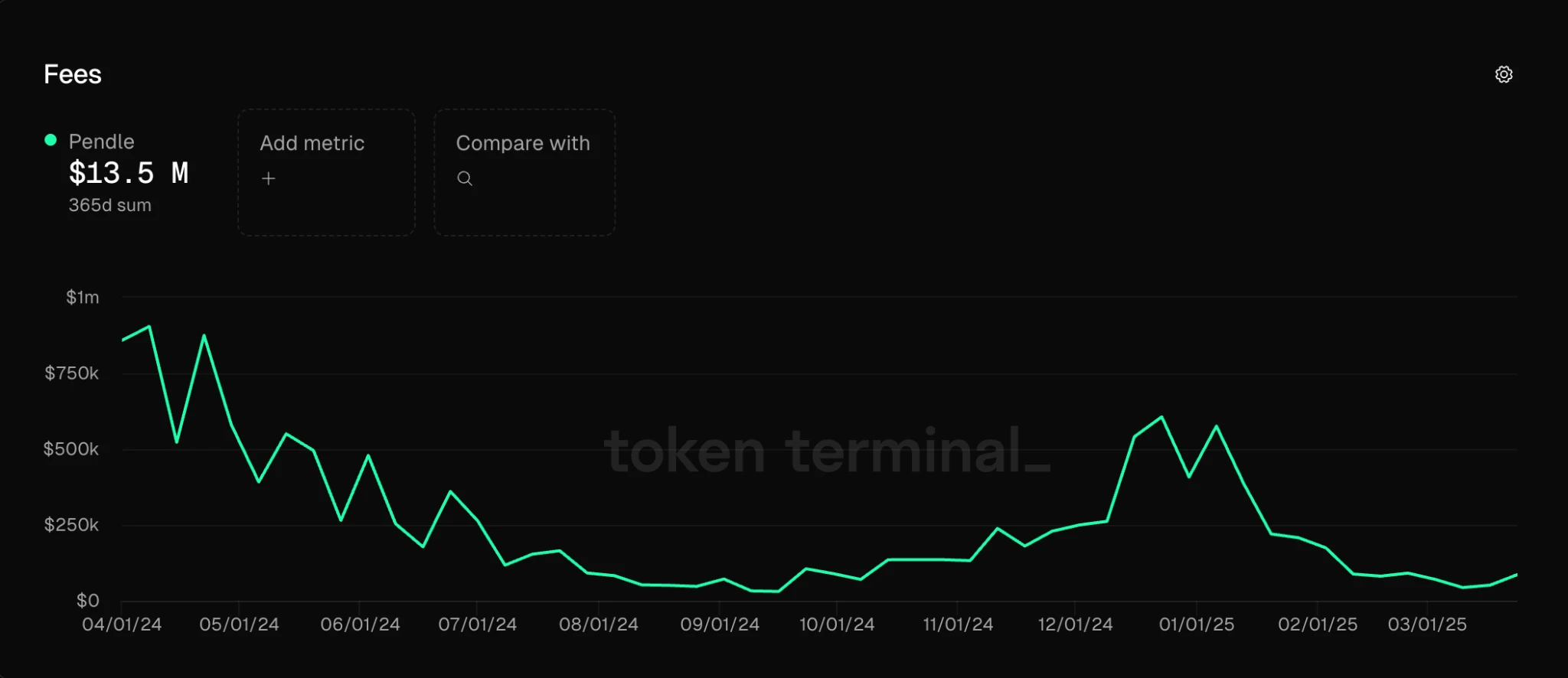
Pendle Fees, source: Pendle
In the past year, Pendle's swap fee income has been $13.5 million, which is entirely distributed to vPendle holders. However, since the protocol itself does not charge fees, and vPendle has other fees amounting to about $24 million, we will use the final cash income of vPendle to value the Pendle token.
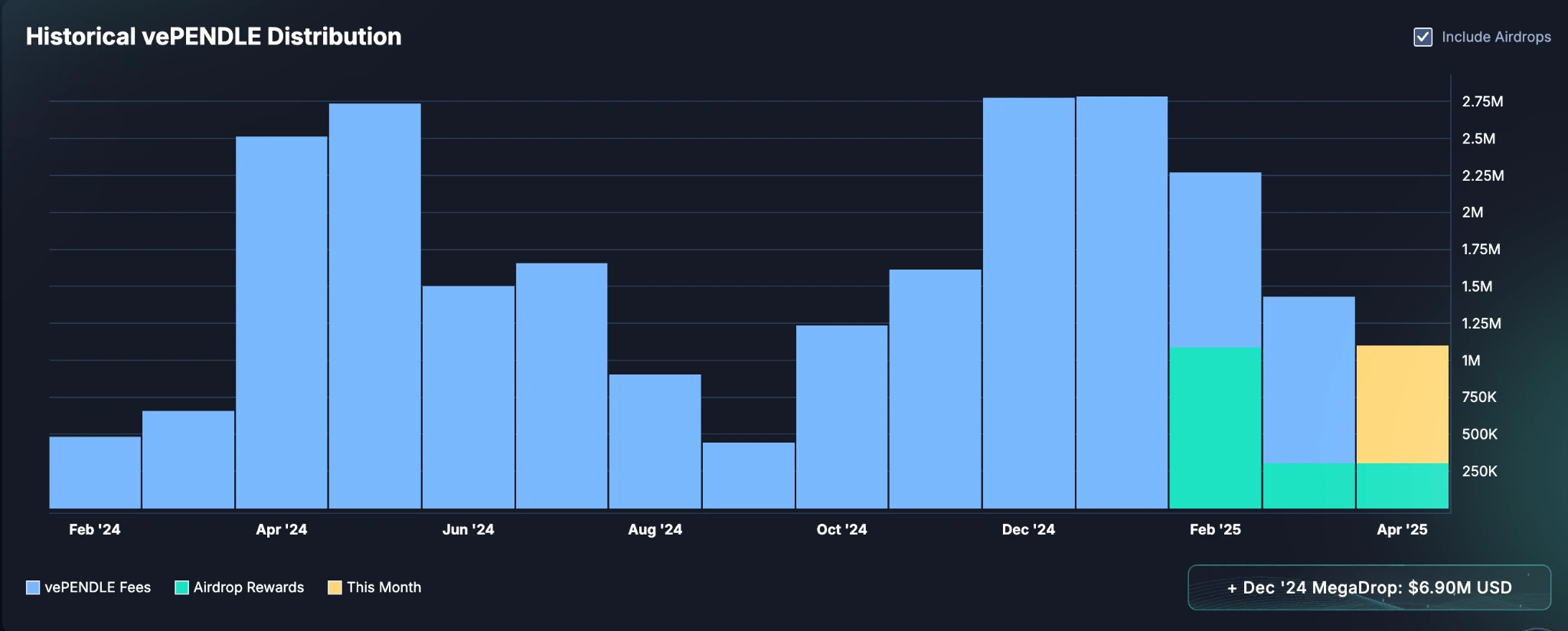
vPendle Holder Dividend, source: Pendle
In the above image, the blue section represents the total fees received by vePendle, the green includes airdrop rewards, and the yellow indicates the real-time profit distribution for that month. Currently, the locked PENDLE amount is 60.78 million, accounting for approximately 21% of the total Pendle supply, with an average lock-up period of 388 days.
In terms of project valuation, since vPENDLE is a fully dividend-type token, we mainly compare it with projects that provide token incentives. For example, Uniswap and Lido have not opened up fee conversion functions, so they are not included in the comparison.
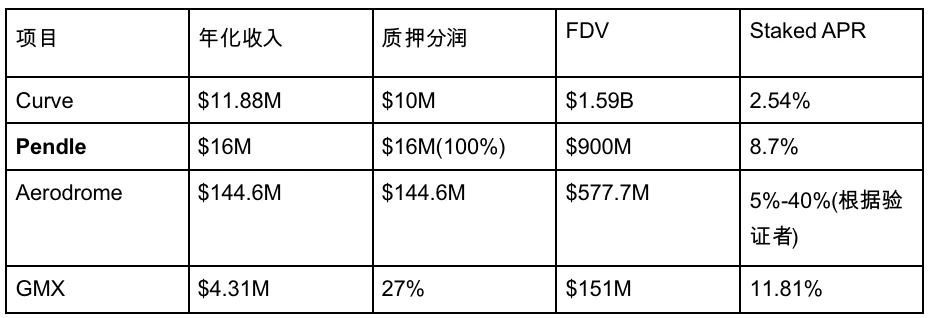
In comparison, Pendle's Staked APR is not particularly outstanding. From this perspective, the market does exhibit a certain premium for Pendle. Next, we will primarily conduct a horizontal comparison of the TVL and market cap ratios of some typical projects.
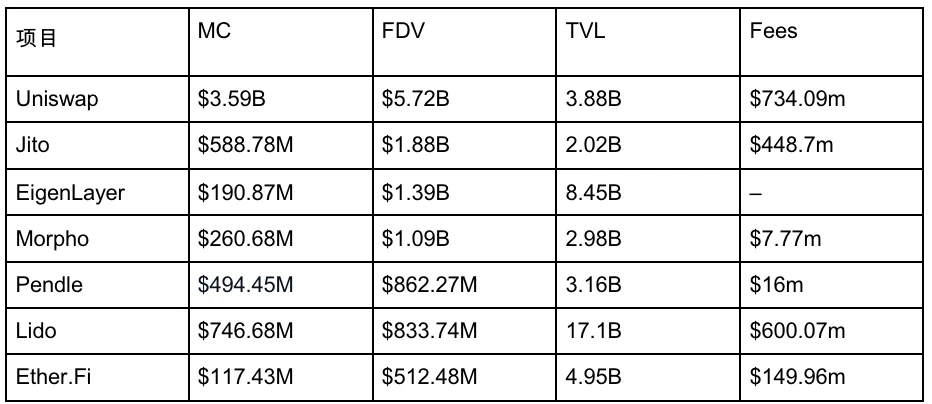
Typical Project Data Comparison
As shown in the image above, we find that the FDV/MC and TVL of the projects are not proportional. The main reason is that FDV only represents the assets managed by the project and cannot be converted into actual future earnings. Therefore, the TVL valuation is no longer effective, and the market is pricing projects more rationally and finely.
Overall, from the perspective of fee income, Pendle does exhibit a certain premium. From the TVL perspective, the market has shifted from TVL valuation, quietly moving from a past focus solely on TVL to a more rational and refined approach. The variance between TVL and FDV is significant, making it unsuitable for valuation.
6.2 Window Period

The above image is calculated by month, so it overlooks peaks and also includes non-fee income, mainly airdrop income. If we only look at fees and calculate on a weekly basis, as shown in the following image:

Pendle swap fees, source: Dune
We observe that Pendle's Swap Fees are highly correlated with the price trend of the token, showing significant interactivity: the peaks of fees often coincide with the peaks of the token price. The peak of fees is also the peak of the token price.
Pendle's swap fees were previously highly related to the LRT Token, mainly due to the popularity of the LRT sector led by EigenLayer, with strong public demand for the points market and YT trading. From June to October 2024, the Pendle ecosystem gradually cooled down as the LRT sector cooled. However, after December 2024, as the market gradually entered a bear phase, retail demand for yield-generating stablecoins began to increase, and the Pendle Swap market reflected a stablecoin-driven trend.

Pendle Price, source: CMC
The end of the LRT ecosystem also marked the bottom of the token price and the bottom of the fees. The turning point was the discovery of a new track for yield-generating stablecoins, and as the yield-generating stablecoin ecosystem peaked in September 2024, the token price also reached its peak. We believe that the stablecoin market still has continuity. Especially with the rising narrative of PayFi, the overall yield decline of altcoins, and increasing external risks, retail demand for on-chain stable yields will continue to grow, further driving the market heat for yield-generating stablecoins.
Overall, the stablecoin market is expected to continue into 2025, which is a common characteristic observed in past cycles. From a fundamental perspective, it currently faces a decline in fee data, and the fee valuation method itself also has a premium, which is a major risk point for short-term token price declines.
6.3 Trading Strategy
Long-term investors: For projects that may have some premium in the short term but have strong long-term potential in terms of brand, diversity of customer base, risk resilience, and market share growth, we recommend participating immediately through dollar-cost averaging. This approach helps balance FOMO and the risks of short-term business decline.
Short to medium-term participants: Due to market volatility in the short term and the significant correlation between Pendle's swap fees and token price, as well as the current slow weekly decline in swap fees, we recommend closely monitoring:
Whether a second wave of the stablecoin market will emerge. Currently, several stablecoin projects have received financing, indicating a potential short-term second wave for stablecoins.
Whether new customer groups will emerge. Previously it was LRT, now it is stablecoins, both related to interest rates. This represents a mid-term turning point and indicates the heat of a sector, which is quite noticeable.
6.4 Risk Warning
Smart Contract Risk: Although Pendle has operated for three years without major security incidents and has undergone multiple audits (such as Spearbit and ChainSecurity), as a highly complex DeFi protocol, there are still potential risks of contract vulnerabilities. Some contracts have pause functions (such as the SY contract) that can suspend operations in emergencies to protect user assets.
Underlying Asset Risk: The value of PT derives from the stability of its underlying assets. For example, if an asset like stETH or sUSDe experiences price decoupling, it will affect the final value of PT. Insufficient liquidity, centralization risks, or governance failures of the corresponding assets can also transmit risks to the Pendle protocol.
Price Risk Outside the AMM Range: Pendle's AMM is built for PT/SY and has a fixed maximum supported yield range. When the actual yield exceeds this range, the trading price of PT may "move out of range," causing the AMM to be unable to provide effective quotes and relying solely on the order book, resulting in a significant decrease in liquidity. If PT is used for collateralized lending, it may lead to overvaluation, arbitrage opportunities, or liquidation failures.
7. References
"Pendle PT Risk Framework," chaos labs
"Pendle v2 Mechanism Risk Assessment," chaos labs
"Pendle 2025: Zenith," pendle
"Pendle Me Softly: Unraveling the Complexities of Yield Tokenization," Alexander Abramovich
Disclaimer:
This content does not constitute any offer, solicitation, or advice. You should always seek independent professional advice before making any investment decisions. Please note that Gate.io and/or Gate Ventures may restrict or prohibit all or part of the services from restricted areas. Please read their applicable user agreement for more information.
About Gate Ventures
Gate Ventures is the venture capital arm of Gate.io, focusing on investments in decentralized infrastructure, ecosystems, and applications that will reshape the world in the Web 3.0 era. Gate Ventures collaborates with global industry leaders to empower teams and startups with innovative thinking and capabilities, redefining the interaction patterns of society and finance.
Official website: https://ventures.gate.io/
Twitter: https://x.com/gate_ventures
Medium: https://medium.com/gate_ventures
免责声明:本文章仅代表作者个人观点,不代表本平台的立场和观点。本文章仅供信息分享,不构成对任何人的任何投资建议。用户与作者之间的任何争议,与本平台无关。如网页中刊载的文章或图片涉及侵权,请提供相关的权利证明和身份证明发送邮件到support@aicoin.com,本平台相关工作人员将会进行核查。




